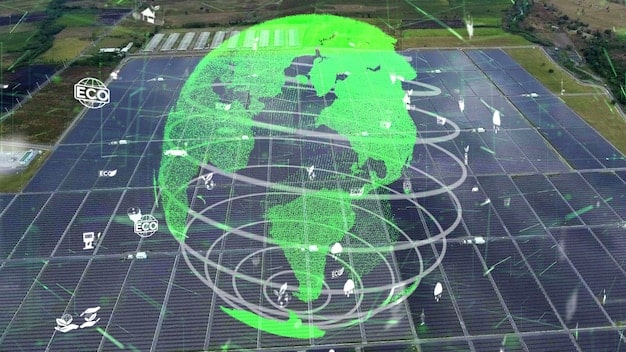Congress Approves Bill to Increase Funding for Renewable Energy Projects by 25%

The US Congress has recently passed a landmark bill significantly increasing funding for renewable energy projects by 25%, aiming to accelerate the nation’s transition to a sustainable energy future and combat climate change, marking a crucial pivot in federal investment priorities.
In a significant legislative move, the United States Congress has given its stamp of approval to a pivotal bill designed to **increase funding for renewable energy projects by 25%**. This landmark decision signals a renewed national commitment to sustainable energy sources, aiming to accelerate the transition away from fossil fuels. It represents a critical step in addressing climate change and bolstering energy independence for the nation.
The Landmark Bill: A New Era for Renewable Energy
The recent congressional approval of increased funding for renewable energy marks a pivotal moment in American energy policy. This legislative initiative seeks to inject substantial capital into projects focused on solar, wind, geothermal, and other clean energy technologies. The bill itself reflects a growing bipartisan consensus on the urgency of climate action and the economic opportunities inherent in the green energy sector. It acknowledges that transitioning to renewables is not merely an environmental imperative but also a strategic economic move that can create jobs and foster innovation.
The core tenets of this legislation are built upon several years of research and advocacy. Experts have consistently pointed to the need for sustained federal investment to scale up renewable energy infrastructure and make these technologies more competitive with traditional energy sources. The 25% increase in funding is expected to primarily target research and development (R&D) initiatives, infrastructure upgrades, and incentives for private sector adoption. This comprehensive approach aims to tackle various bottlenecks in the renewable energy sector, from technological limitations to grid integration challenges. The bill also includes provisions for workforce development, ensuring that the necessary skills are available to support the burgeoning green economy.
One of the bill’s primary objectives is to stimulate innovation within the renewable energy landscape. By channeling more funds into R&D, the hope is to unlock new breakthroughs that can further reduce costs and improve efficiency. This includes advancements in energy storage solutions, smart grid technologies, and new materials for solar panels and wind turbine blades. Furthermore, the legislation aims to address the disparities in access to clean energy, with specific allocations for projects in underserved communities. This ensures that the benefits of the clean energy transition are broadly distributed across the population, fostering energy equity.
Addressing Infrastructure and Grid Modernization
The existing power grid in the United States, in many areas, is aging and not fully equipped to handle the influx of intermittent renewable energy sources like solar and wind. This bill allocates significant funds to upgrading and modernizing the national grid, making it more resilient, efficient, and capable of integrating a higher percentage of renewable power.
* Investment in smart grid technologies to optimize energy flow.
* Expansion of transmission lines to connect remote renewable energy sites to population centers.
* Development of advanced energy storage systems, such as battery farms.
* Cybersecurity enhancements for critical energy infrastructure.
Incentivizing Private Sector Investment
While federal funding is crucial, the long-term success of the renewable energy transition depends heavily on private sector participation. The bill includes various tax credits, grants, and loan programs designed to de-risk investments in renewable energy projects and make them more attractive to private companies and investors. This public-private partnership model is considered essential for achieving the ambitious climate goals set by the government. The framework of these incentives is carefully designed to encourage both large-scale utility projects and smaller, distributed generation initiatives.
The passage of this bill is seen by many as a strong signal to the international community that the United States is serious about its climate commitments. It is expected to encourage other nations to follow suit, potentially leading to a global acceleration in renewable energy adoption. The economic impact could be substantial, creating thousands of new jobs in manufacturing, construction, research, and technical services. Overall, this legislation positions the U.S. at the forefront of the global clean energy race, with significant implications for both environmental protection and economic growth.
Economic Implications: Job Creation and Market Growth
The increased funding for renewable energy projects, now boosted by 25% with congressional approval, is poised to unleash a wave of positive economic activity across the United States. This substantial investment is not just about environmental benefits; it is fundamentally about economic growth and opportunity. The renewable energy sector has consistently been a significant job creator, and this new influx of capital is expected to supercharge that trend. From the manufacturing of solar panels and wind turbines to their installation and maintenance, a wide array of new jobs will emerge. These jobs often require diverse skill sets, ranging from high-tech research and development to skilled trades and project management.
The direct economic impact will be visible in areas where renewable energy projects are developed. Rural communities, often seeking new economic drivers, stand to benefit significantly from large-scale wind and solar farms. These projects bring construction jobs during their development phase and long-term operational and maintenance roles thereafter. Additionally, they can provide stable lease payments to landowners and generate tax revenues for local governments, supporting schools and public services. This economic revitalization can help diversify local economies, reducing reliance on traditional industries that may be in decline.
Beyond direct job creation, the enhanced funding will also stimulate growth in ancillary industries. The demand for raw materials, components, and specialized services will naturally increase, benefiting supply chain businesses. This includes everything from advanced materials manufacturers to transportation and logistics companies. The ripple effect extends to engineering firms, consulting services, and financial institutions that support renewable energy development. This interconnected growth fosters an entire ecosystem around clean energy, creating a more diversified and resilient national economy.
Investment and Innovation Hubs
States and regions that proactively invest in renewable energy infrastructure and research are likely to become innovation hubs. This new funding can further accelerate this trend, attracting more private capital and talent.
* Development of specialized training programs and educational curricula.
* Emergence of new startups focused on renewable energy technologies.
* Increased venture capital investment in promising green tech ventures.
* Strengthening of research partnerships between universities and industry.
Strengthening Energy Independence
From an economic security perspective, relying less on volatile global fossil fuel markets offers substantial benefits. Increased domestic renewable energy production reduces the nation’s exposure to geopolitical risks and price fluctuations. This stability can translate into more predictable energy costs for businesses and consumers, fostering a more stable economic environment. The bill’s emphasis on domestic manufacturing and supply chains further reinforces this economic independence, creating jobs within the U.S. rather than outsourcing them. The commitment to a quarter increase in funding is a clear indicator that policymakers view renewable energy not just as an environmental solution, but as a robust economic engine.
The economic implications extend to American global competitiveness. As more countries shift towards green economies, being a leader in renewable energy technology and deployment provides a competitive edge in international markets. It opens up export opportunities for American-made renewable energy products and services, further boosting economic growth and influence. Ultimately, this bill’s funding increase is a strategic investment in the future economic prosperity of the United States, designed to yield returns in jobs, innovation, and energy security.
Environmental Impact: Accelerating the Clean Energy Transition
The environmental implications of Congress approving a 25% increase in funding for renewable energy projects are profound and overwhelmingly positive. This significant financial injection is expected to accelerate the nation’s transition away from fossil fuels, a critical step in mitigating climate change and improving public health. By making clean energy technologies more accessible and economically viable, the bill directly contributes to a reduction in greenhouse gas emissions, which are the primary drivers of global warming. The long-term effects of this shift will be a cleaner atmosphere, healthier ecosystems, and a more sustainable planet for future generations.
Transitioning to renewable energy sources like solar and wind power dramatically reduces air pollution. Fossil fuel combustion releases harmful pollutants such as particulate matter, sulfur dioxide, and nitrogen oxides, which contribute to respiratory illnesses, cardiovascular diseases, and other public health issues. By phasing out coal-fired power plants and reducing reliance on natural gas, the bill will lead to tangible improvements in air quality, especially in urban and industrial areas. This has direct benefits for public health, potentially saving lives and reducing healthcare costs associated with pollution-related illnesses.
Furthermore, the expansion of renewable energy helps conserve natural resources and protects delicate ecosystems. Extracting and transporting fossil fuels often involves destructive practices like mining, drilling, and pipeline construction, which can lead to habitat destruction, water contamination, and land degradation. Renewable energy projects, once established, have a much smaller environmental footprint, especially when properly sited. This allows for the preservation of pristine natural areas and a reduction in the ecological disturbances typically associated with energy production. The bill’s funding supports responsible development practices to further minimize environmental impact.
Reducing Carbon Footprint and Mitigating Climate Change
The core environmental benefit of this bill is its direct contribution to lowering the United States’ carbon footprint. Each megawatt-hour generated by solar or wind power replaces electricity from fossil fuels, preventing emissions of carbon dioxide and other potent greenhouse gases.
* Direct reduction in national greenhouse gas emissions.
* Contribution to meeting established climate targets and international agreements.
* Setting a precedent for other nations to increase their renewable energy investments.
* Promotion of carbon-neutral energy generation methods.
Protecting Biodiversity and Water Resources
Renewable energy development, particularly solar and wind, offers significant opportunities to protect biodiversity and water resources compared to conventional energy sources. Fossil fuel industries are often water-intensive and can lead to significant water pollution. Renewable energy, in contrast, reduces water consumption in energy production and minimizes the risk of spills or leaks that could harm aquatic life. This focus on environmental stewardship is a key component of the bill’s overarching objectives, ensuring that economic progress does not come at the expense of ecological health. The 25% funding increase underlines a firm commitment to these environmental imperatives.
The ripple effect of this environmental progress extends globally. As a major emitter, the U.S. significantly ramping up its renewable energy efforts sends a powerful message and provides a model for other nations. This leadership can inspire greater international cooperation on climate action, potentially accelerating the global transition to a clean energy economy. The environmental benefits of this congressional decision are not just theoretical; they are tangible improvements that will positively impact human health and planetary well-being for generations to come.
Technological Advancements and Future Prospects
The congressional approval to increase funding for renewable energy projects by 25% is poised to be a major catalyst for technological advancements within the sector. While existing renewable technologies like solar photovoltaics and wind turbines are already highly efficient, there’s always room for improvement, and this increased investment will fuel critical research and development. The goal is not only to make current technologies more cost-effective and scalable but also to explore next-generation solutions that could revolutionize energy production and storage. This forward-looking approach ensures long-term sustainability and competitiveness in the global energy landscape.
One key area where technological progress is highly anticipated is energy storage. The intermittency of solar and wind power remains a challenge, and advanced battery technologies, pumped-hydro storage, and even forms of thermal storage are crucial for ensuring a reliable grid. Increased funding can accelerate research into new battery chemistries that are safer, cheaper, and have higher energy densities. This includes solid-state batteries, flow batteries, and other innovative solutions that could store vast amounts of renewable energy for periods when the sun isn’t shining or the wind isn’t blowing. Such breakthroughs would unlock even greater potential for renewable integration.
Beyond storage, the bill’s funding will likely spur innovation in the efficiency and design of solar panels and wind turbines. For solar, this could mean multi-junction cells that capture more of the solar spectrum, transparent solar technologies for integration into buildings, or more durable and recyclable materials. For wind, advancements might include taller turbines that access stronger winds, offshore wind technology improvements, or even airborne wind energy systems. These advancements aim to maximize energy capture from available resources and reduce the overall footprint of renewable energy installations, making them more environmentally compatible.
Smart Grid and Grid Modernization
The concept of a “smart grid” relies heavily on advanced technology to manage electricity flow more efficiently, integrate diverse energy sources, and respond to demand fluctuations. This bill will support technologies essential for a truly smart and resilient grid:
* Artificial intelligence (AI) and machine learning for predictive energy management.
* Advanced sensors and communication networks to monitor grid health in real-time.
* Blockchain technology for secure and transparent energy transactions.
* Distributed energy resource management systems for localized energy solutions.
Emerging Renewable Technologies
While solar and wind dominate the current renewable landscape, the funding increase also opens doors for the commercialization and scaling of less mature technologies. Geothermal energy, for instance, has immense untapped potential, especially with advancements in enhanced geothermal systems (EGS). Similarly, tidal and wave energy, while currently niche, could benefit from increased R&D to become viable alternatives in coastal regions. Hydrogen production through electrolysis, powered by renewable energy, is another area expected to see significant investment, paving the way for a hydrogen economy that could decarbonize hard-to-abate sectors like heavy industry and transportation.
The future prospects stemming from this increased funding are robust. It establishes the U.S. as a leader in clean energy innovation, attracting top talent and fostering a dynamic research ecosystem. This commitment ensures that the nation remains at the forefront of the global energy transition, developing and deploying the technologies necessary to achieve a truly sustainable and carbon-neutral future. The 25% boost in funding is more than just a financial allocation; it’s an investment in a technologically advanced and environmentally responsible tomorrow.
Implementation Challenges and Overcoming Hurdles
While the congressional approval of a 25% funding increase for renewable energy projects is a monumental achievement, its successful implementation will inevitably face a range of challenges. Translating legislative intent into tangible, operational projects requires navigating complex regulatory landscapes, securing land, managing supply chains, and addressing social and economic considerations. Overcoming these hurdles will be crucial to realizing the full potential of this substantial investment and ensuring that the United States truly accelerates its clean energy transition efficiently and equitably.
One of the primary challenges lies in the sheer scale of infrastructure development required. Building new solar farms, wind parks, and transmission lines demands extensive permitting processes that can be time-consuming and bureaucratic. Environmental assessments, land acquisition, and local zoning approvals often lead to delays and cost overruns. Streamlining these processes while ensuring environmental protection and community engagement will be essential. Effective coordination between federal, state, and local agencies will be paramount to prevent bottlenecks and accelerate project deployment. This includes optimizing interconnection queues for new renewable projects to connect to the grid.
Another significant hurdle involves the supply chain for renewable energy components. While the bill aims to boost domestic manufacturing, the immediate demand for materials like critical minerals (e.g., lithium, cobalt, rare earth elements) and specialized equipment could strain global supplies. Ensuring a robust and resilient supply chain, potentially through strategic alliances with international partners and investments in domestic mining and processing, will be vital to avoid material shortages and price volatility. Diversifying sources and developing recycling capabilities for end-of-life components also contribute to long-term supply chain stability.
Workforce Development and Skilled Labor Gaps
The rapid expansion of the renewable energy sector creates a high demand for skilled labor. From engineers and project managers to technicians and construction workers, there’s a need for a trained workforce.
* Establishing new vocational training programs and apprenticeships.
* Retraining workers from fossil fuel industries for new green jobs.
* Addressing potential labor shortages in high-demand fields.
* Ensuring equitable access to training and employment opportunities.
Community Engagement and Social Acceptance
Large-scale renewable energy projects require significant land use and can sometimes face resistance from local communities concerned about visual impact, noise, or property values. Effective community engagement, transparent communication, and ensuring that local populations benefit economically from projects are crucial for gaining social acceptance and avoiding protracted disputes. This includes offering local job opportunities, community benefit funds, and addressing concerns about infrastructure development. The success of the 25% funding increase hinges on a collaborative approach that respects local interests and integrates community feedback into project planning.
Furthermore, integrating a higher percentage of intermittent renewable energy onto the existing grid poses technical challenges for grid operators. Ensuring grid stability and reliability requires sophisticated management systems, advanced forecasting tools, and significant investments in energy storage solutions. Overcoming these implementation challenges will require a multi-faceted approach involving policy innovation, technological advancement, strategic planning, and robust public-private partnerships. The commitment to increased funding provides the financial resources, but effective execution will be the true test of this legislation’s impact.
Comparing with Other Nations: US Position in Global Renewable Race
With Congress approving a 25% increase in funding for renewable energy projects, the United States is signaling a strong intent to bolster its position in the global renewable energy race. For years, several nations have outpaced the U.S. in terms of renewable energy deployment and investment, often driven by aggressive national policies and clear long-term goals. This new bill represents a significant push for the U.S. to not only catch up but potentially emerge as a leading force in the global transition to clean energy. Understanding where the U.S. stands relative to other nations provides crucial context for this legislative shift.
For a considerable period, countries in Europe, such as Germany and Denmark, have been pioneers in renewable energy, particularly wind and solar. Their success has been underpinned by robust feed-in tariffs, substantial public subsidies, and ambitious national targets for decarbonization. China has also emerged as a colossal player, leading the world in both renewable energy capacity additions and the manufacturing of clean energy technologies, including solar panels and electric vehicles. Their strategic investments and long-term industrial policies have positioned them as a dominant force in the global supply chain. This 25% funding increase aims to empower the U.S. to compete more effectively with these established leaders.
The U.S. has often lagged due to inconsistent federal policies and a more fragmented approach to energy policy across states. While some states like California and Texas have made significant strides, a cohesive national strategy with sustained financial backing was often missing. This new bill attempts to provide that consistent push from the federal level, offering a more predictable and supportive environment for renewable energy development across the entire country. It aims to reduce policy uncertainty, which has historically deterred some private investors from committing large sums to renewable projects in the U.S.
Key Players and Strategies
Several nations employ distinct strategies to advance their renewable energy sectors. The U.S. can learn from their successes and adapt their models while leveraging its own unique strengths.
* China: Massive scale manufacturing and domestic deployment targets.
* European Union (EU): Ambitious decarbonization goals, cross-border grid integration, and carbon pricing mechanisms.
* India: Focus on affordable solar and rural electrification through renewables.
* Australia: High per capita solar adoption and significant investments in large-scale solar and battery projects.
US Strengths and Opportunities
Despite past challenges, the United States possesses several inherent advantages that position it well to become a global renewable energy leader. It has vast renewable resource potential, including abundant sunshine, strong winds, and geothermal hot spots. Its robust research institutions and innovative private sector are also major assets. The 25% funding increase can accelerate breakthroughs in areas like advanced energy storage, grid modernization, and next-generation renewable technologies where the U.S. can truly lead. This investment is not just about adopting existing technologies but also about pioneering new ones.
The global renewable energy market is rapidly expanding, and nations that establish strong domestic industries and supply chains will reap significant economic benefits. By increasing funding, the U.S. aims to capture a larger share of this market, creating jobs and fostering economic growth at home. This strategic investment positions the U.S. to be a more competitive and influential player in international climate negotiations and clean energy trade, asserting its commitment to a sustainable future on a global stage. The decision directly impacts America’s standing in this critical global competition.
Long-Term Vision: A Sustainable Energy Future
The congressional decision to increase funding for renewable energy projects by 25% is deeply rooted in a long-term vision for a sustainable energy future for the United States. This isn’t merely a short-term legislative fix but a strategic commitment designed to reshape the nation’s energy landscape for decades to come. The goal extends beyond simply reducing carbon emissions; it encompasses creating a resilient, secure, and economically vibrant energy system that benefits all Americans. This holistic approach recognizes that energy policy and environmental stewardship are intrinsically linked to national prosperity and security.
A key component of this long-term vision is complete energy independence. By harnessing abundant domestic renewable resources—sunlight, wind, thermal energy from the earth—the U.S. can significantly reduce its reliance on volatile international fossil fuel markets. This enhances national security, insulates the economy from global energy price shocks, and allows for greater control over the energy supply. The increased funding accelerates the development of a diverse energy portfolio, ensuring that the nation has robust and reliable power sources even as the climate changes and global dynamics shift. This diversified approach builds inherent resilience into the energy system.
The vision also includes a highly efficient and modernized national grid, capable of seamlessly integrating distributed renewable energy sources. This means moving away from a centralized, unidirectional power system to a smarter, more dynamic grid that can handle power flowing from multiple points, including homes, businesses, and large-scale power plants. Investments in smart grid technologies, energy storage, and advanced control systems will be critical to achieve this. Such a grid would not only be more reliable but also more secure against cyber-attacks and natural disasters.
Equitable Transition and Community Benefits
A just and equitable transition is central to the long-term vision. This involves ensuring that the benefits of the clean energy economy reach all communities, especially those historically reliant on fossil fuel industries.
* Targeted investments in underserved and frontline communities.
* Support for workforce retraining programs to transition workers to green jobs.
* Addressing energy poverty and ensuring affordable access to clean energy.
* Promoting environmental justice by reducing pollution burdens in vulnerable areas.
Innovation and Global Leadership
The sustained investment facilitated by the 25% funding increase aims to solidify the U.S. as a global leader in renewable energy innovation. This long-term commitment to research and development will drive technological breakthroughs that not only benefit the domestic market but can also be exported worldwide. This positioning fosters economic competitiveness and reinforces the nation’s role in addressing global environmental challenges. Ultimately, the long-term vision is of a U.S. powered predominantly by clean, renewable energy, providing a model for sustainable development and an engine for sustained economic growth that improves quality of life for all citizens.
This bill is a step towards a future where clean energy is the norm, not the exception. It envisions a United States that is not only energy independent but also a global beacon for environmental responsibility and technological progress. The sustained commitment implied by this increased funding promises to turn this ambitious vision into a tangible reality, building a more resilient, healthier, and prosperous nation for generations to come.
| Key Aspect | Brief Description |
|---|---|
| 💸 Bill’s Impact | Increases US funding for renewable energy projects by 25%. |
| 💡 Economic Benefits | Expected to create jobs, boost market growth, & enhance energy independence. |
| 🌱 Environmental Goals | Aims to rapidly accelerate the clean energy transition & reduce emissions. |
| ⚡ Future Outlook | Fosters technological innovation & solidifies US global leadership in renewables. |

Frequently Asked Questions About Renewable Energy Funding
The primary objective of the newly approved bill is to significantly boost the United States’ transition to clean energy by increasing federal funding for renewable energy projects by 25%. This aims to accelerate the deployment of solar, wind, and other clean technologies, foster innovation, create jobs, and reduce the nation’s carbon footprint and reliance on fossil fuels.
The increased funding is expected to be allocated across several critical areas, including research and development (R&D) for next-generation renewable technologies, infrastructure upgrades for the national grid, and various incentives for private sector investment. It will also support workforce development and projects in underserved communities to ensure equitable access to clean energy benefits.
Economically, the legislation is anticipated to create a substantial number of jobs in the renewable energy sector, from manufacturing and installation to research and maintenance. It will also stimulate market growth, attract private investment, enhance energy independence by reducing reliance on foreign energy sources, and potentially stabilize energy costs for consumers and businesses.
By significantly accelerating the deployment of renewable energy, the bill will lead to a substantial reduction in greenhouse gas emissions from fossil fuels. This directly contributes to mitigating climate change, improving air quality, and protecting natural ecosystems. It also signals a strong U.S. commitment to its international climate targets, encouraging global action.
Implementation challenges may include navigating complex permitting processes for new infrastructure, ensuring a robust and resilient supply chain for renewable components, and addressing potential shortages of skilled labor. Overcoming these hurdles will require strong coordination between government agencies, private industry, and local communities to ensure efficient project deployment.

Paving the Way for a Brighter Future
The approval by Congress to increase funding for renewable energy projects by 25% represents a turning point in the United States’ energy policy. It underscores a strong and bipartisan commitment to a sustainable future, recognizing the imperative of addressing climate change while simultaneously driving economic growth and enhancing energy security. This substantial investment is not just about financial allocation; it’s a strategic decision that will catalyze technological innovation, create significant job opportunities, and solidify the nation’s position as a leader in the global clean energy transition. While implementation challenges will undoubtedly emerge, the overarching vision and the resources now dedicated indicate a determined path forward. This landmark bill lays a solid foundation for a cleaner, more resilient, and prosperous energy landscape for generations to come.





